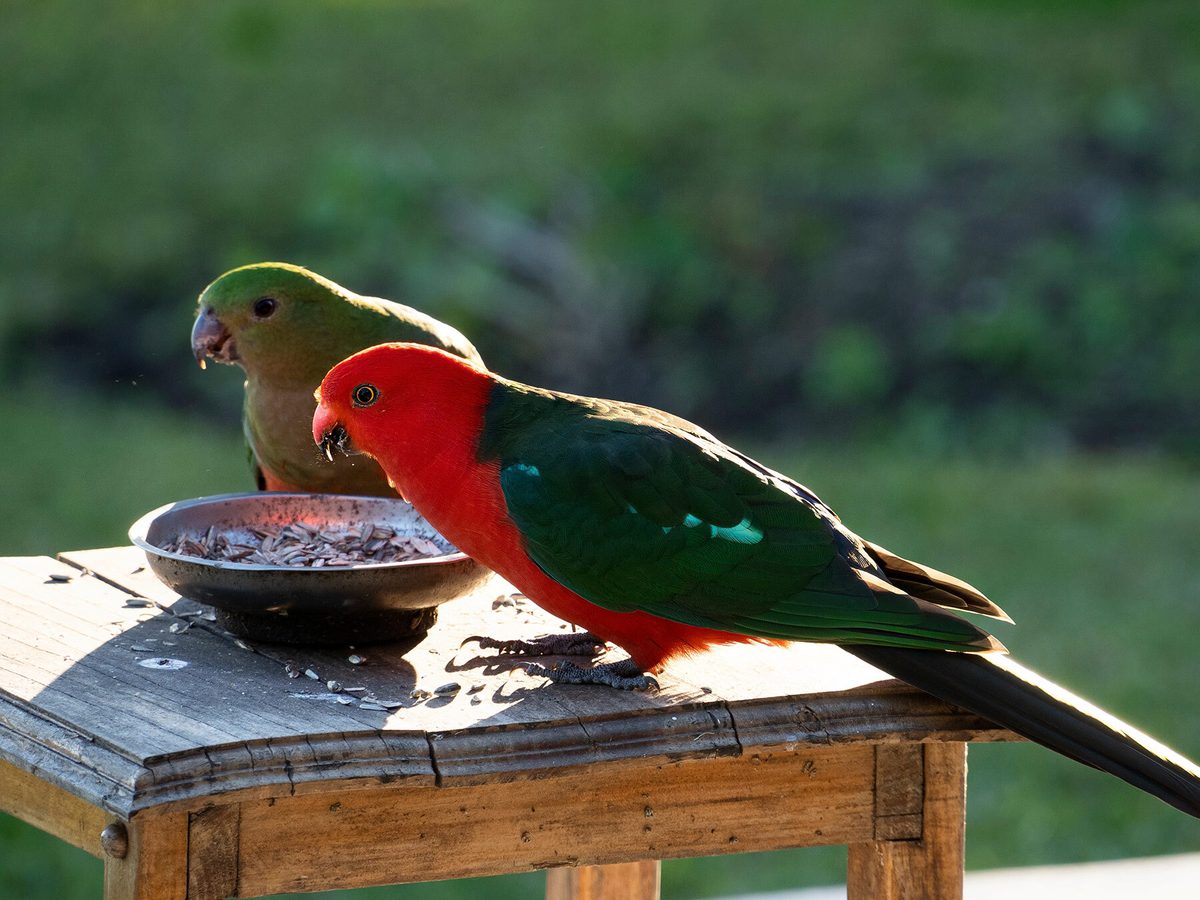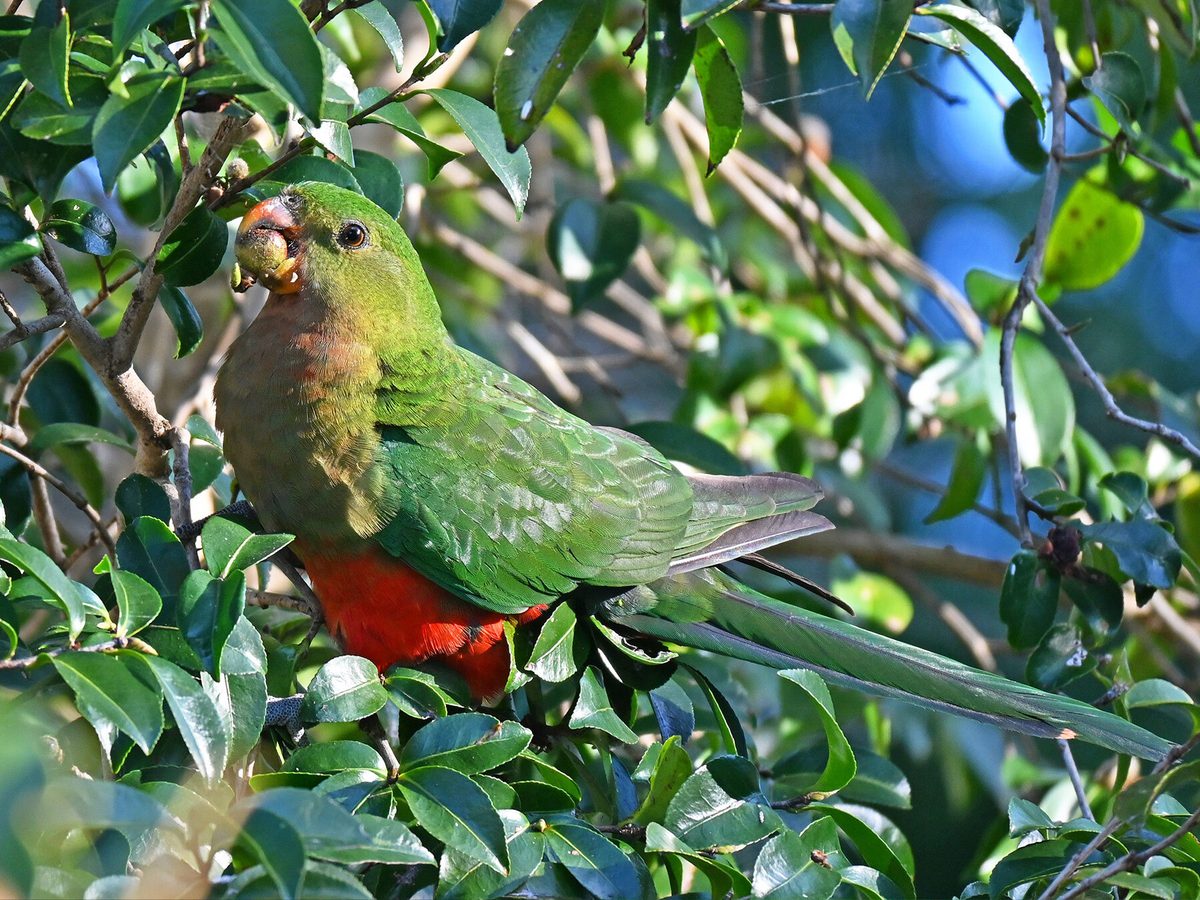There are three King parrots in the Alisterus genus of Australasian parrots; the Australian King parrot, the Papuan King parrot, and the Moluccan King parrot. The Australian King parrot is by far the most common, and the other two are comparatively rare.
Like many parrots, male and female King parrots possess different colored plumage, a form of sexual dimorphism called sexual dichromatism.
The male Australian King parrot has a red head and breast, a blue stripe across the back of its neck, and a gray shoulder band. The female has a green head and neck and lacks the blue stripe and shoulder band. Other than that, males and females are pretty much identical.
Sexual dimorphism in parrots and other birds is usually related to mating and breeding, but this isn’t always the case with other birds. For example, many female raptors are larger than the male, which may help them defend their young and hunt for larger prey than the male.
For parrots, however, the male’s brighter, bolder plumage likely helps them compete for mates.
Read on to learn more about female King parrots and how to identify them from males.

Close up of a Female King Parrot perched on the fence, Sarsfield, regional Victoria
How can you tell if a King parrot is male or female?
Male Australian King parrots have a bright red head, breast, and underside with a blue stripe across the back of their neck and a gray patch or shoulder band on each side, above the wing. Contrastingly, the female Australian King parrot has a green head and back with a lighter green breast and a red underside.
The female lacks the blue stripe and gray shoulder patch across the neck. You can tell male and female Australian King parrots apart by the male’s red head and breast compared to the female’s green head and breast.
Another key difference is the beak, which is dark for the female, whereas the male’s upper bill is half orange-red with a black tip.
Besides the differences in color, both the male and female look alike and are a similar size with similar proportions.
Male and female Papuan King parrots also differ, but only by their blue neck stripe, which the female lacks. Female Papuan King parrots are red and green like males.

Female King Parrot

Male King Parrot
What does a female King parrot look like?
Female Australian King parrots have an olive-green head and breast, which fades gradually from olive-green to lighter green and then to red.
Their belly and undersides are red, extending to a green tail with a blue rump. Their backs are also olive-green, the same color as their head. In addition, female King parrots have dark bills, unlike males, which have orange-red upper bills with a darker low bill.
The Papuan King parrot is more similar to the male, with a red breast and head and olive-green back and wings, with a green-yellow band across the wing, which is less prominent than in the male. Female Papuan King parrots also lack a blue patch on the back of their necks.

Australian King Parrot female perched on a branch
Are female King parrots bigger than males?
There is no difference between male and female parrots in terms of size and proportion. Aside from their plumage, male and female King parrots are near-identical.
Differences between juvenile King parrot males and females
Juvenile male and female King parrots look more like adult females, with olive-green heads, breasts, back, and tails. Juveniles have brown irises and a yellow-orange beak.
The male doesn’t molt its juvenile plumage for around 1 to 1.5 years. Molting is a slow process that can take a further year.

Male (foreground) and female King parrot pair feeding on sunflower seeds
Behavior differences
There aren’t many notable behavioral differences in male and female King parrots.
The male King parrot displays courtship behavior that involves him puffing up his red plumage to attract a mate. Like most parrots, King parrots are presumed to mate for life - but there’s little evidence to clarify whether this is the case.
Female King parrots lay a clutch of around 5 eggs which she incubates without the assistance of the male.
Calls and vocalizations
King parrots are reasonably quiet compared to other parrots. Their vocalizations are sharp and metallic, the most common is a sharp whistle kee, kee, kee. In addition, they produce guttural cackles while feeding and a harsh kreck sound when flying.
King parrots are not known for their mimicry and don’t ‘learn to talk’ like other parrots. When kept in captivity, they’re often reasonably quiet.

Close up portrait of an Australian King Parrot female
Nesting and feeding
Australian King parrots nest between September to January in their east Australian range. They choose a deep tree hollow in which to build a simple nest.
Clutch sizes number between 3 and 6 eggs, which the female solely incubates for around 20 years. The nestlings remain in the nest for around five weeks before fledging.
Most parrot couples are cooperative and work together to raise the young, so it wouldn’t be a surprise if King parrots were the same. However, there are few studies or observations of Australian King parrot behavior.

Female King parrot eating a camellia bud
Can female King parrots raise young alone?
Female King parrots reportedly incubate the young without the male’s assistance. However, there is little evidence to describe whether or not the male feeds the young or takes care of them after they hatch.
The female may be able to incubate the eggs on her own, but whether she can then raise the nestlings through to fledging without the male’s assistance is unclear.
Do female King parrots sing?
There’s no evidence to suggest that female King parrots have different calls to males, but the males likely sing more in the breeding season to attract a mate. Many species of parrots are loud and chatty, but King parrots are relatively quiet.

A female (left) and male (right) King Parrot sitting in a wisteria bush
What color are female King parrots?
Female Australian King parrots are primarily olive-green, with a green head, breast, back, and tail. They have a blue rump and red underside and belly.
The male’s head and breast are red rather than olive green. Females also lack the blue neck stripe and gray shoulder patch possessed by the males.
